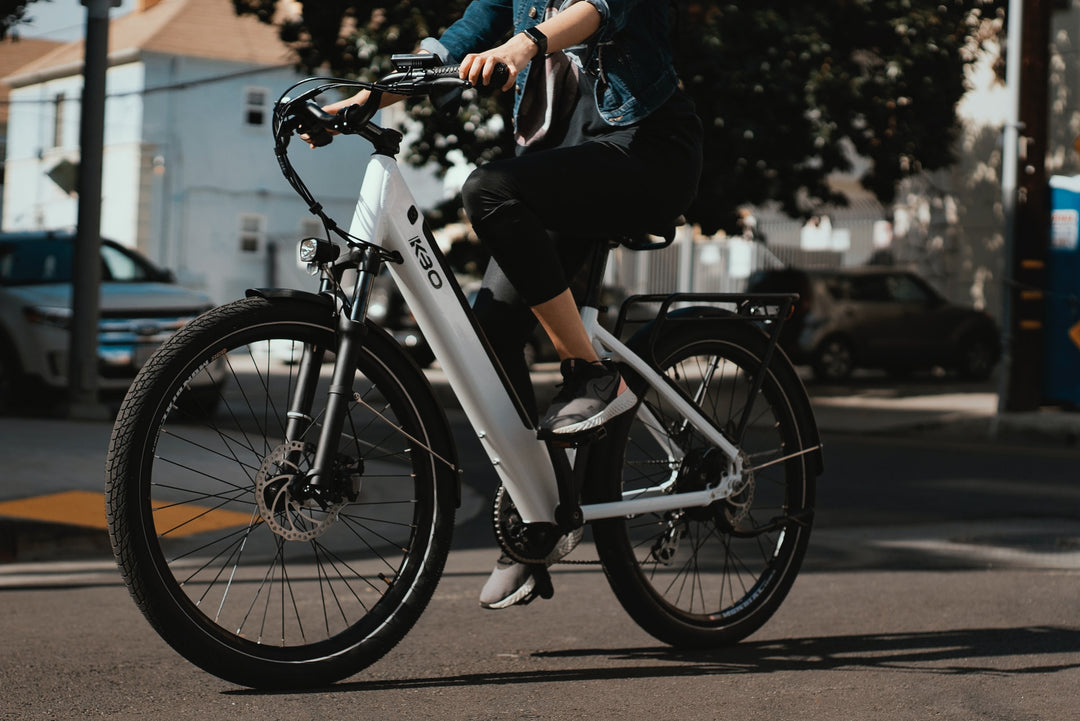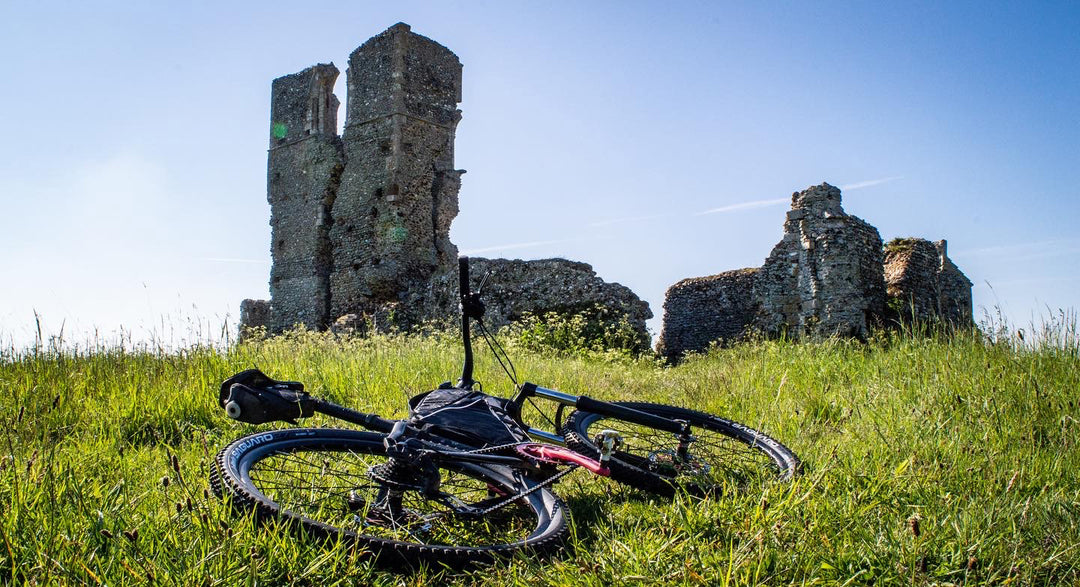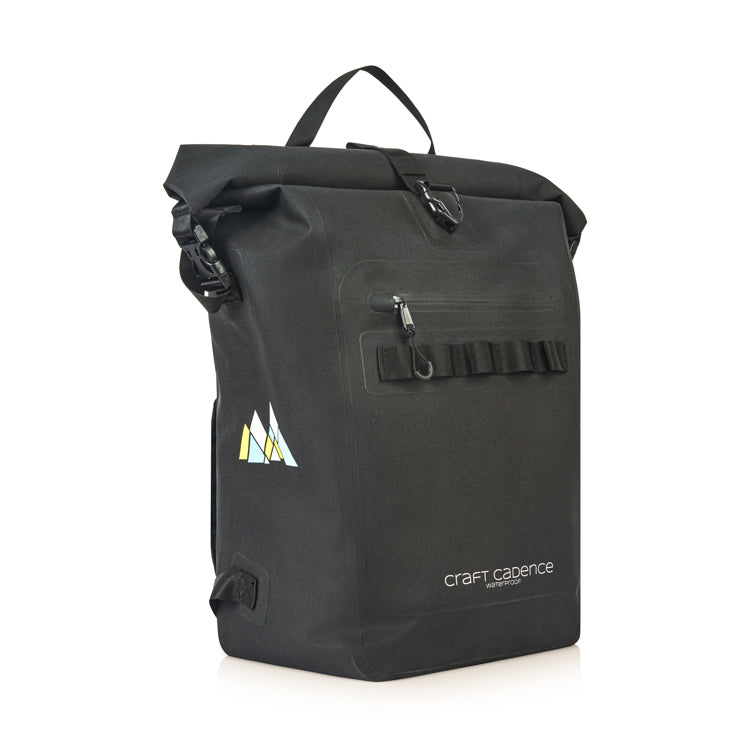Introduction to gears for roadbike commuting!
Have you ever been out commuting or riding and found the conditions in which you couldn't find the correct gearing? Trying to find the gearing choice and balance between being stuck in a too high gear or having too low cadence can easily make your commute harder than it should be. The bicycle's gearing is one of the easily misunderstood components on a bike, so choosing the right combination can significantly help your performance whether it's commuting or general riding.
While there are many types of combinations from Triple to double and single options below we focus mainly on double cranksets, which are the most common on road bikes in 2017.
The typical road bike nowadays comes with two chain rings on the front. Which then either comes in a 50/34t, 50/36t or a 52/36t. These can be broken down into three categories, compact crankset (50/34t), semi compact crankset (52/36t) and a standard crankset (53/39t). The harder the gears on the front of the bike is calculated by the higher the number of teeth on each chainring, which means the more teeth on the chainrings require a higher power output and the higher the riders top end speed would be
While the front gear combinations you have limited options, the rear provides many different combinations, which can confuse the average commuter. The gearing range like the front chainrings is marked by the number of teeth on the cassette.
The most common sizes of a cassette are typically 11-23t, 11-25t, 11-28t, 12-23t, 12-25t, 12,28t. These are of course the most common with newer road bikes but with newer rear derailleurs now able to handle up to 32t. Of course these ratios depend entirely on the gear number you have on the back, which affects the step between each cog (or gear).
If we break this into cassette categories as an example a
11/12/13/14/15/17/19/21/23/25 is called a "11-25"
11/12/13/14/15/17/19/21/24/28 is called a "11-28"
12/13/14/15/16/17/18/19/21/23 is called a "12-23" and so forth.
The higher the number of gears on the rear, means the teeth of each cog can be closer in ratio, meaning there is less jump between gears. Allowing a closer step between each gear allows you to control both you Heartrate, power and cadence better so you don't get stuck in a too hard of a gear when climbing or too easier gear when descending.
If we take two different types of commuting areas. Flat and Hillier, the hillier terrain means your lower gear needs to be able to provide an easy enough gear ratio to get over the climbs without needing to come to a standstill while allowing you to control your cadence.
Depending on the climbs or the gradient, the 50/34 or 50/36t crankset can be paired with numerous cassettes on the rear.
Usually the more the gradual climbs are the closer the number of teeth can be on the rear cassette. A climb that is constantly changing gradient, you would need a broader range of teeth on the cassette, such as an 11-28t.
Since cadence is changing quite dramatically on the steeper gradients you can account for this with an easier gear, while still having the lower number of teeth or harder gears for the lower gradient sections.
This also comes into play with descending, cassettes such as 11-28t allows the 11t to be used when descending, overall giving you a slightly higher top end speed.
For the commuter that needs to commute of hilly terrain, moving into a compact crankset allows a bigger range of lower gear ratios for the climbs, Combining a 50/34t crankset or a 50/36t crankset allows even the most beginner cyclists the ability to get over the climbs without too much trouble.
A flatter city or terrain is relatively easier. Depending on the level of fitness you have, usually, a larger front gearing combination is more commonly used.
Because you are naturally holding a higher average speed, compared to that of a hilly area, you just have the wind that affects your gearing choices.
Picking a larger from crankset such as a 53/39t, allows you a higher top end speed with a tailwind, and combining this with a closer step between each gear on the back allows you to fine tune your cadence.
For example, a 53/39t paired with an 11-23t cassette. Since you don't have the constant change in gradients when climbing, the choice of gearing on the back can become tighter, meaning there is a less jump in the number of teeth between each cog.
While the 39t inner chainring on the front allows small enough gearing for the head wind sections
So if we put these two types of terrains together, or if your budget doesn't allow you to pick and choose your gear ratios, Shimano like other brands in the past few years have released a semi compact crankset. This means this can provide a big enough front chainring for descending (52 teeth)or on the flat while the inner chainring allows a small enough gearing for a climbing (36teeth).
This 52/36t crankset combination is becoming more and more popular with riders since it allows for the best of both worlds. This front gearing combination allows you to customize the rear gearing, for the rear and hillier areas we can go for a larger cassette (up to 30t) and for the flatter terrain a smaller ratio (11-25t).
While there a numerous models of gears, speeds and for different models of bikes, the most common gearing on a road bike is broken down in this order (from cheapest to most expensive)
Shimano sora
Shimano Tiagra
Shimano 105
Shimano Ultegra
Shimano Dura Ace
Shimano Ultegra Di2 (eletronic)
Shimano Duraace Di2 (eletronic)
While the upper level of electronic gearing is not needed for the average commuter and is usually beyond their reach, Shimano 105 is a good recommendation for the commuter.
While allowing an 11 speed on the rear, the ability to have a closer ratio or larger choice of gearing is a plus for the commuter.
While the cheaper groupsets such as Sora and Tiagra are a good investment for your first commuter this limits the ability to customize the gearing as that of the 105 groupsets.
Cover Photo by Riccardo Cuppini / CC BY
While there are many types of combinations from Triple to double and single options below we focus mainly on double cranksets, which are the most common on road bikes in 2017.
Basics of Gear Ratios.
Front chainring (front gears)
The typical road bike nowadays comes with two chain rings on the front. Which then either comes in a 50/34t, 50/36t or a 52/36t. These can be broken down into three categories, compact crankset (50/34t), semi compact crankset (52/36t) and a standard crankset (53/39t). The harder the gears on the front of the bike is calculated by the higher the number of teeth on each chainring, which means the more teeth on the chainrings require a higher power output and the higher the riders top end speed would be
Rear cassette (rear gears)
While the front gear combinations you have limited options, the rear provides many different combinations, which can confuse the average commuter. The gearing range like the front chainrings is marked by the number of teeth on the cassette.
The most common sizes of a cassette are typically 11-23t, 11-25t, 11-28t, 12-23t, 12-25t, 12,28t. These are of course the most common with newer road bikes but with newer rear derailleurs now able to handle up to 32t. Of course these ratios depend entirely on the gear number you have on the back, which affects the step between each cog (or gear).
If we break this into cassette categories as an example a
11/12/13/14/15/17/19/21/23/25 is called a "11-25"
11/12/13/14/15/17/19/21/24/28 is called a "11-28"
12/13/14/15/16/17/18/19/21/23 is called a "12-23" and so forth.
The higher the number of gears on the rear, means the teeth of each cog can be closer in ratio, meaning there is less jump between gears. Allowing a closer step between each gear allows you to control both you Heartrate, power and cadence better so you don't get stuck in a too hard of a gear when climbing or too easier gear when descending.
Picking the right gearing for the conditions
If we take two different types of commuting areas. Flat and Hillier, the hillier terrain means your lower gear needs to be able to provide an easy enough gear ratio to get over the climbs without needing to come to a standstill while allowing you to control your cadence.
Depending on the climbs or the gradient, the 50/34 or 50/36t crankset can be paired with numerous cassettes on the rear.
Usually the more the gradual climbs are the closer the number of teeth can be on the rear cassette. A climb that is constantly changing gradient, you would need a broader range of teeth on the cassette, such as an 11-28t.
Since cadence is changing quite dramatically on the steeper gradients you can account for this with an easier gear, while still having the lower number of teeth or harder gears for the lower gradient sections.
This also comes into play with descending, cassettes such as 11-28t allows the 11t to be used when descending, overall giving you a slightly higher top end speed.
For the commuter that needs to commute of hilly terrain, moving into a compact crankset allows a bigger range of lower gear ratios for the climbs, Combining a 50/34t crankset or a 50/36t crankset allows even the most beginner cyclists the ability to get over the climbs without too much trouble.
Flat Terrain
A flatter city or terrain is relatively easier. Depending on the level of fitness you have, usually, a larger front gearing combination is more commonly used.
Because you are naturally holding a higher average speed, compared to that of a hilly area, you just have the wind that affects your gearing choices.
Picking a larger from crankset such as a 53/39t, allows you a higher top end speed with a tailwind, and combining this with a closer step between each gear on the back allows you to fine tune your cadence.
For example, a 53/39t paired with an 11-23t cassette. Since you don't have the constant change in gradients when climbing, the choice of gearing on the back can become tighter, meaning there is a less jump in the number of teeth between each cog.
While the 39t inner chainring on the front allows small enough gearing for the head wind sections
Undulating terrain
So if we put these two types of terrains together, or if your budget doesn't allow you to pick and choose your gear ratios, Shimano like other brands in the past few years have released a semi compact crankset. This means this can provide a big enough front chainring for descending (52 teeth)or on the flat while the inner chainring allows a small enough gearing for a climbing (36teeth).
This 52/36t crankset combination is becoming more and more popular with riders since it allows for the best of both worlds. This front gearing combination allows you to customize the rear gearing, for the rear and hillier areas we can go for a larger cassette (up to 30t) and for the flatter terrain a smaller ratio (11-25t).
Models of groupsets/gearing
While there a numerous models of gears, speeds and for different models of bikes, the most common gearing on a road bike is broken down in this order (from cheapest to most expensive)
Shimano sora
Shimano Tiagra
Shimano 105
Shimano Ultegra
Shimano Dura Ace
Shimano Ultegra Di2 (eletronic)
Shimano Duraace Di2 (eletronic)
While the upper level of electronic gearing is not needed for the average commuter and is usually beyond their reach, Shimano 105 is a good recommendation for the commuter.
While allowing an 11 speed on the rear, the ability to have a closer ratio or larger choice of gearing is a plus for the commuter.
While the cheaper groupsets such as Sora and Tiagra are a good investment for your first commuter this limits the ability to customize the gearing as that of the 105 groupsets.
Cover Photo by Riccardo Cuppini / CC BY



